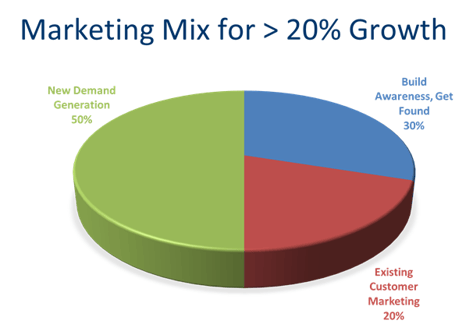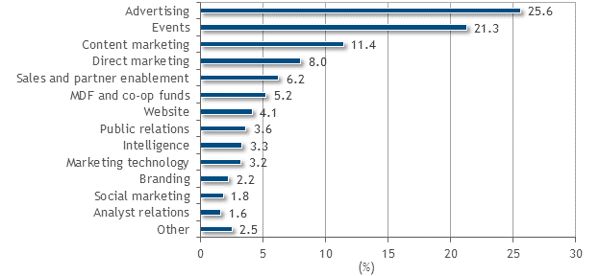Achieve Greater Than 20% Revenue Growth with Your Marketing Mix

March 13, 2018

Has your business plateaued?
Is it stagnant?
Are your sales and marketing organizations not generating enough demand and/or new business?
Are you eager to grow your revenue by greater than 20% YOY?
Your marketing program investment mix is likely impacting your growth plans. Marketing mix gets right to the heart of awareness building, traffic generation, lead generation, and customer acquisition.
I have listed three proven marketing mix changes that will propel your business to new revenue heights.
Then again, if you desire to do the same things you have done in the past, expect the same results.
3 Proven Marketing Mix Changes to Achieve Greater Than 20% Revenue Growth
1. Event Marketing
.jpg?width=300&name=tsl-marketing-google-event-min%20(1).jpg)
There is no doubt that events can be successful marketing and sales activities.
However, how much new business have you acquired from industry, national, or regional events?
Companies fill exhibit halls with elaborate booths, displays, tchotchke’s (thank goodness for spellchecking), or giveaways to lure people into their booths. Yet, most prospects attending a conference have one primary goal, visiting several vendors and/or booths to explore their options.
Yes, that’s right.
Prospects leave your booth to engage with most of your competitors. It’s the business version of the ‘Bachelor’ or ‘Bachelorette’!
Did I mention the costs and resource demands of running events?
Most companies have an entire staff solely devoted to events or they are outsourcing the lion’s share of the work at a premium price.
Also, have your sales reps been successful following up on leads from an event or conference?
Most often the leads are not followed up or actioned.
A recent study by Salesforce revealed that 80% of trade show exhibitors don’t follow up on show leads. I can speak to this from experience, having managed an event staff for over a decade and sales organizations for 20 years.
I wish I knew then what I know now.
The trend nowadays is small, more localized events. I do believe this strategy can work well, especially as a lead progression tactic. However, it is growing increasingly difficult to get people to attend events in person.
I recommend you focus on a mix of existing customers, customers you want to grow wallet share with, and net-new customer targets for your localized/regional events. Also, a solid post event strategy that includes regular outreach to attendees or leads should be included in your event plan. Customer appreciation events (ball games, concerts, etc.) do very little to grow your business. They are a retention strategy and should be used as such.
In summary, events should remain a part of your marketing mix.
However, it is best to invest less than 20% of your overall marketing budget so you can focus the majority of your investments on marketing activities that generate more substantial revenue growth.

2. New Demand Generation Activities
This is where the rubber meets the road.
If you want to grow your revenues by double digits or greater than 20%, then you must acquire new customers. Period.
How do you go about acquiring new customers in the digital era?
I recommend you invest 50% or more of your marketing budget on new demand generation activities including but not limited to targeted online advertising, lead generation via outbound/direct marketing, content marketing, and social media marketing/selling.
A recent survey in 2017 by IDC found that most technology companies are investing more than ¼ of their marketing budget on advertising.
Marketing Program Investment Mix in 2017

Source: IDC's Tech Marketing Benchmark Survey, 2017
While I am recommending advertising as a vehicle to generate demand and leads for your business, please be cautious on how, when, and where you advertise.
It’s all about being recognized, known and trusted by your industry, market, or target audience. A recent Moz blog post suggests getting to know your audience first. Make sure they see you are a leader in your space.
As with any good advertising campaign, having an optimized and current website will demonstrate your abilities and expertise.
Do not invest your hard-earned marketing budget on a “spray and pray” advertising approach where you cast a substantially wide net and waste your investment on impressionable marketing only.
Be targeted in your advertising approach and test methods, mediums, and channels that will help you get in front of your target audience more effectively and efficiently and allow you to convert them into qualified demand and leads.
Additionally, do not forget about the human element.
Prospects have the power and control of the buyer’s journey in the digital world we live in. They can do most of their research, analysis, and evaluation without the help of a person. However, there is a point in time when human engagement, help, and support is vital to the success of converting an interested prospect into a qualified lead or customer.
Remember, your approach to nurturing, progressing, and converting leads should be “ABH” or “always be helping” versus the old school sales approach of “ABC” or “always be closing.”
The late and great Steven Covey included the following as one of the 7 habits of highly successful people: “Seek first to understand, then to be understood.”
[Related post: How to Optimize LinkedIn Advertising]
3. Strengthen Your BOFU (Bottom of Funnel)
You can radically change your marketing mix and still achieve limited results if you don’t strengthen your BOFU.
No, this is not a new muscle group in the human body or workout fad.
BOFU is an important sector of the funnel for a business desiring to grow.
It is one of the reasons why 70% of companies surveyed by HubSpot believe that their top marketing priority is “converting leads into customers.”

Source: HubSpot, State of Inbound, 2017
Let’s say you have done everything by the book and run a successful marketing initiative that produced leads at every stage of the funnel, including a number of sales-qualified leads (SQL’s) that you have delivered to your sales organization.
Your sales team has accepted the leads and committed to following up.
How many of the SQL’s do you think the sales team will ACTUALLY engage, progress, and close?
I wish I could tell you that the answer is most all of them. In my experience, less than half of them will receive the attention they deserve while the largest percentage will go nowhere.
Studies have shown that sales representatives will “cherry-pick” the more pressing and “HOT” leads or opportunities and focus little time on the longer-term ones. In fact, only 8% of salespeople said leads they received from marketing were very high quality. (Source: HubSpot, State of Inbound, 2017)
The reality is that we should not be blaming the sales organization for your company’s shortfall on BOFU lead conversion.
The fact is that sales organizations lack the support, training, expertise, and/or time needed to properly nurture and progress leads. This is especially true for products or solutions that are complex, require large investments, and/or have a longer sales cycle.
Not to mention, many companies have not identified nor armed their sales organizations with compelling offers or incentives for someone to buy from them.
It is becoming extremely important for marketers and companies to recognize they need to help fill the gap (aka, plug the leaky funnel) to ensure that highly qualified demand is converting to later sales stages and potentially into new customers.
Alignment, cooperation, and collaboration between marketing and sales teams is critical to your success in converting BOFU leads to opportunities to new customers. They must work together to identify their roles and responsibilities and who owns what at each stage of the funnel.
Deploying a more systematic and comprehensive lead progression methodology and approach will help you dramatically improve conversion rates.
One best practice is creating Service-Level Agreements (SLA’s) for both Marketing and Sales. This can help establish accountability and improve marketing effectiveness by 3x. (Source: HubSpot, State of Inbound, 2017)

Source: HubSpot, State of Inbound, 2017
In conclusion:
If you are looking to achieve greater than 20% revenue growth for your business, revisit your marketing mix.
It’s been proven to help you drive awareness, traffic and leads and acquire new customers. Be bold and lucky at the same time. The great Thomas Jefferson once said, “I am a great believer in luck, and I find the harder (and smarter) I work, the more I have of it.”
Offer end March 31, 2018.
Comments